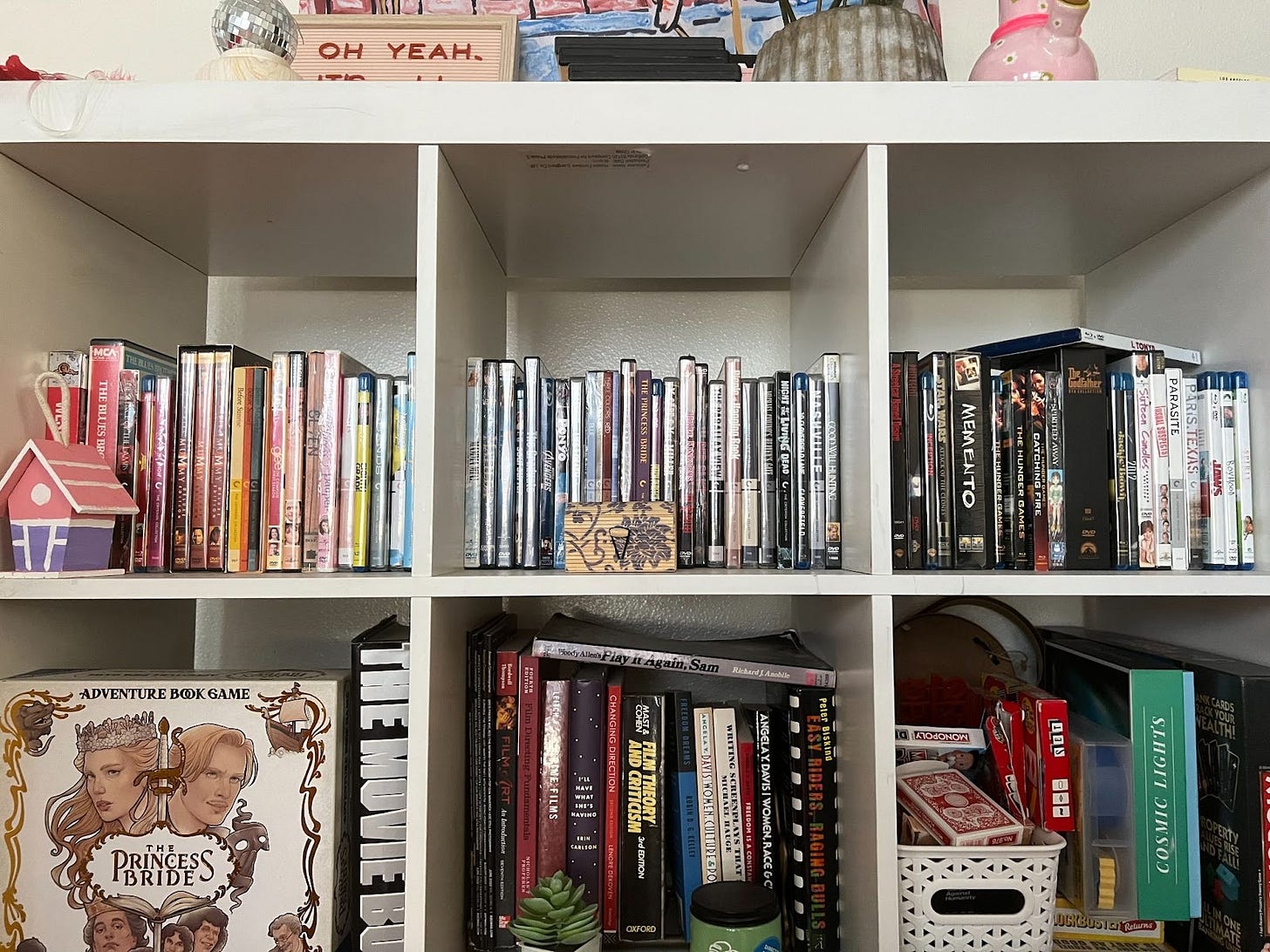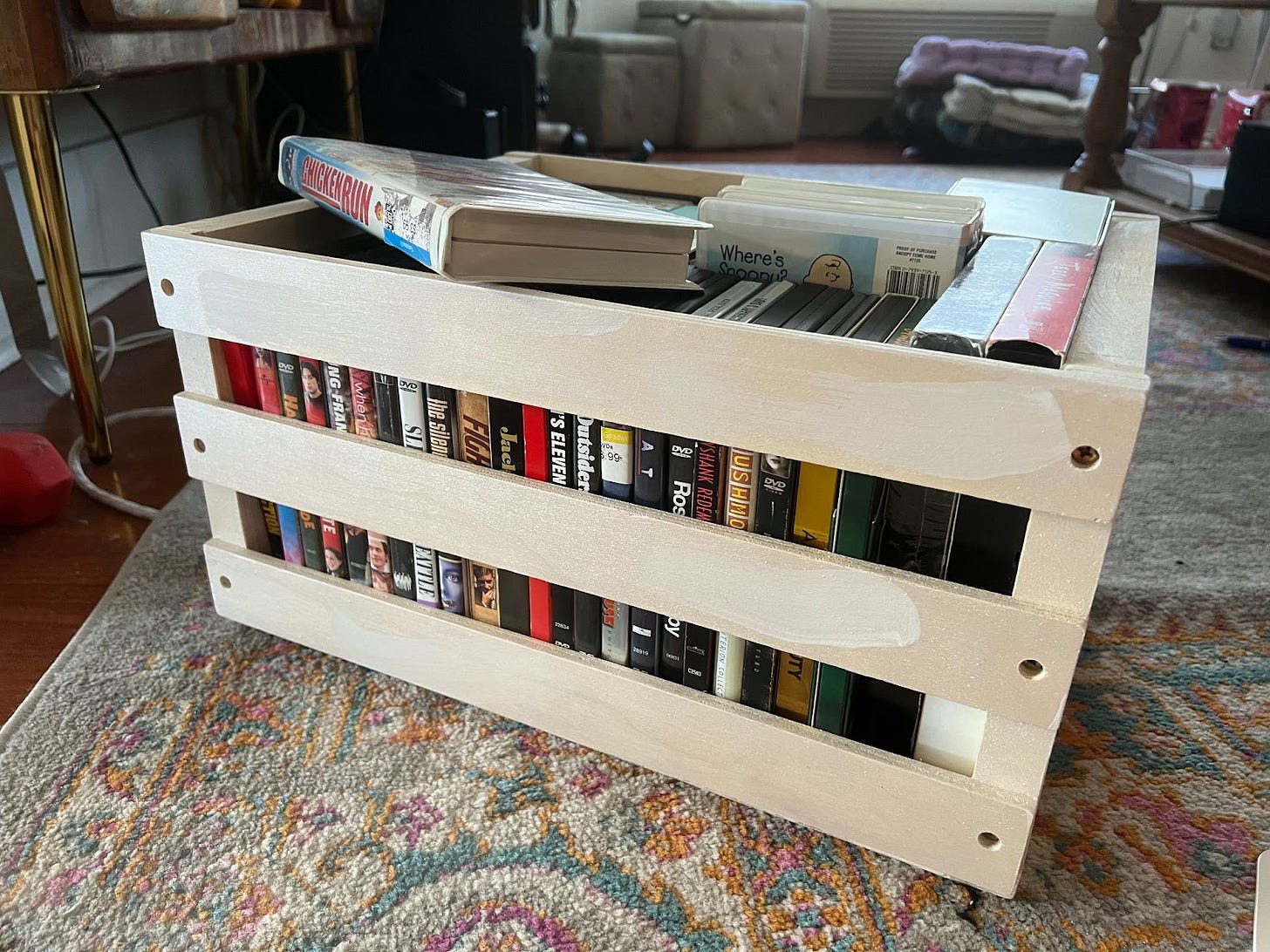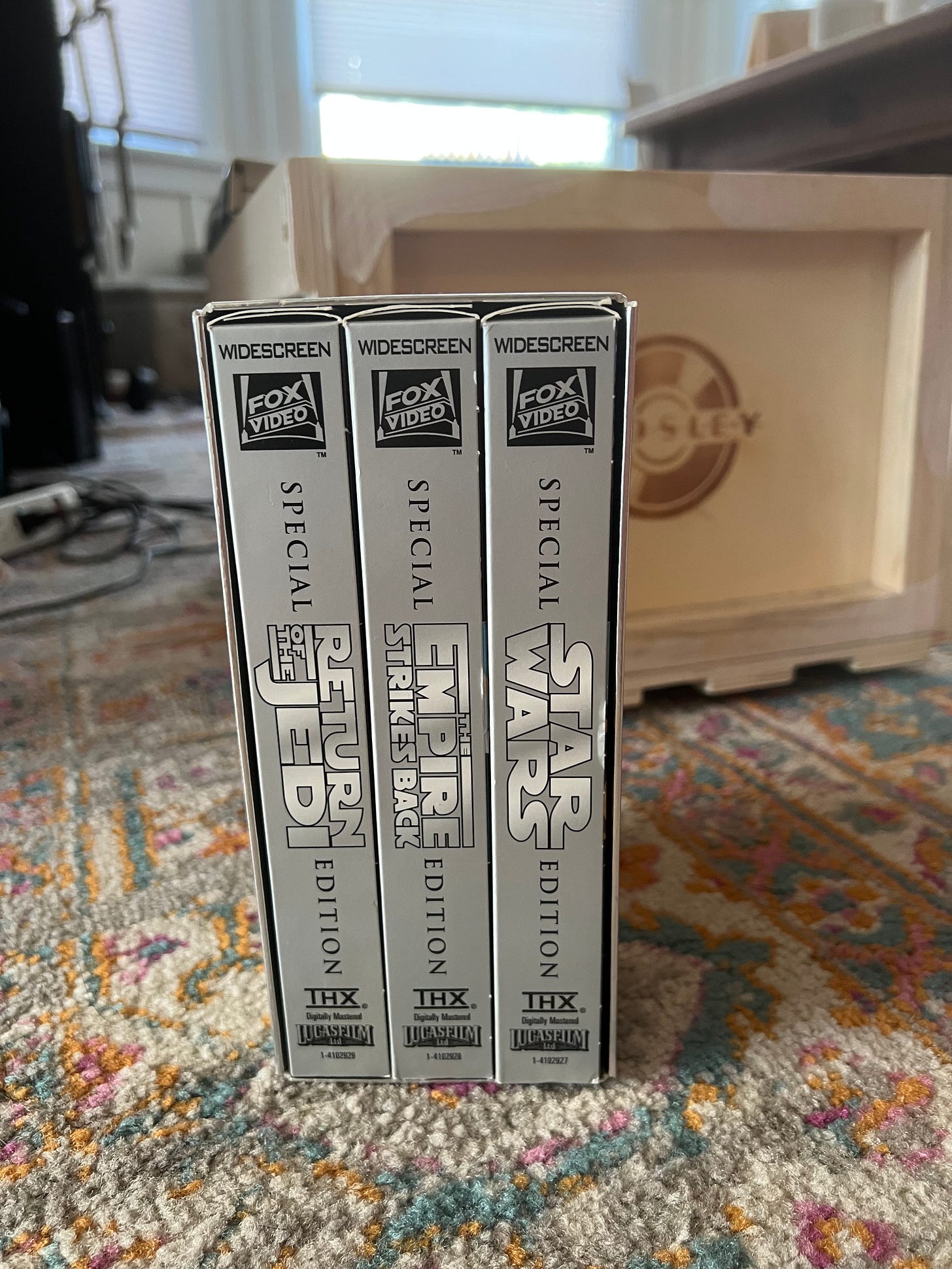The Importance of DVDs and Physical Media in a Streaming Dominant Era
Part 1
Ever since I was little, I have had an admiration for film. My family had an extensive DVD and VHS collection as I was growing up—much of which I still own. I always loved sliding the tape/disc in and hearing it whirr and spin. Something was so charming about the occasional scratch, it almost became a part of the movie and something felt off when a scratch wasn’t where it was supposed to be. My dad is the root of my love for film, he would (illegally) download movies for us to listen to in the car as well as burning our favorites onto hard DVD copies. As streaming has become the dominant form of home entertainment, I have grown to love and appreciate physical media and have become a strong advocate for building an archive. Before I take you into my collection, we’re going to dive into a bit of history.
The world of home entertainment has undergone quite the journey through the decades, faced with fierce competition, technological leaps, and evolving consumer preferences. To kick things off, let’s begin with the first generation, where Sony’s Betamax faced off against Matsushita’s (Panasonic) VHS. In 1975, Sony introduced Betamax, followed by the 1976 launch of VHS. These two formats would clash head-to-head into the 1980s, marking the first Format War. When Sony introduced Betamax, they believed it was superior and expected other companies to adopt it as the industry standard. However, JVC did not follow suit and VHS initially had an advantage with longer recording times, so Sony extended Betamax recording times. JVC did the same, leading to a technology arms race. Eventually, recording capacity ceased to be a differentiator, and marketing took over the battlefield. VHS gained an edge, largely due to JVC licensing their technology to major electronics companies, expanding the availability of VHS machines and lowering prices, making them more appealing to consumers. In the early 1980s, video rental stores became popular, and they preferred VHS due to its lower cost and wider compatibility. It only snowballed from there, with more VHS machines and home video cameras on the rise, Betamax was eventually forced out of the picture.
Fasting forward to the second generation, we are introduced to the rise of the DVD. In the early 1990s, Sony and Philips presented the multimedia compact disc (MMCD), while Toshiba and its partners produced the super density disc (SD). By 1995, they banded together and gave birth to the digital versatile disc (DVD), a format that offered more storage and longer recording time. The DVD quickly took center stage, and by the mid-2000s, it had established itself as the entertainment media format of choice, and VHS was quickly fading from the scene. Leading electronics retailers such as Circuit City and Best Buy no longer sold movie releases on VHS as of 2005. Mass merchandisers were following suit, with Target set to end VHS retailing before September 2005 and Walmart planning to do the same in early 2006.
As we move to the third generation, we find ourselves amidst a high-definition showdown. Sony's Blu-ray and Toshiba's HD-DVD went head-to-head, each striving to deliver high-definition content to our screens. Sony had a trick up its sleeve with Blu-ray's blue laser technology, which provided a larger capacity and a more detailed high-definition picture. Backed by a consortium of hardware firms and Hollywood studios, Blu-ray had the upper hand. Although based on DVD tech with a blue laser, HD-DVD faced an uphill battle due to Blu-ray's superior capacity and thinner disc layer. The competition included price wars, with HD-DVD initially outselling Blu-ray thanks to lower prices. However, Sony's strategic move to incorporate Blu-ray drives into the PlayStation 3 shifted the tide. By 2008, Blu-ray was firmly in control, securing its place as the superior standard. Hollywood studios were very influential in setting a new standard of high-definition video. Most studios backed Blu-ray technology, favoring its larger capacity. In August 2007, however, Paramount Pictures and DreamWorks Animation announced that their DVD titles would be released exclusively on HD-DVD. But, as of late 2007, Blu-ray titles outsold HD-DVD titles by almost two to one. When critics theorize trans-media storytelling, they typically prioritize film, TV, video games and websites. DVDs and Blu-Rays—physical formats that play an essential role in extending and repurposing media content across new fields—are often overlooked.
The decline in DVD popularity is not just about the numbers; it's about how we watch our content. Streaming services like Netflix and Hulu offer instant access to a vast library of content, making DVDs seem invaluable by comparison. With streaming, you can watch what you want, when you want, and from almost anywhere with an internet connection. The Great Recession also played a role in DVD's decline. Tightening wallets led people to rethink their spending on DVDs, and the rise of video-on-demand and digital downloads provided cost-effective alternatives, allowing people to rent movies for mere cents. Streaming's personalized content recommendations and lower costs further contributed to the shift. Since 2011, streaming services have experienced tremendous growth, with their sales exploding by 1,231%. In contrast, DVD sales plummeted by almost 70% between 2011 and 2018.
Before it upended the entertainment industry and ushering in the streaming era, Netflix was a company whose business model revolved around sending DVDs through the mail in easily recognizable red-and-white envelopes. In 2010, roughly 20 million subscribed to the DVD service. But the practice has long felt anachronistic, and the company sent its final DVDs to customers on Sept. 29. “Those iconic red envelopes changed the way people watched shows and movies at home — and they paved the way for the shift to streaming,” co-chief executive Ted Sarandos stated.
Besides nostalgia, there are many reasons one may want to build an archive of film. Streaming platforms occasionally edit or censor their content to comply with today’s standards and approved content. Disney+ for example, has been known to remove certain scenes or episodes from classic episodes of The Simpsons. I own the season 2 box set, and have watched it time and time again. When watching the season on Disney+ however, it just was not the same. Some people also appreciate having a physical hard copy, we are all too familiar with the pain and frustration of a favorite movie or show leaving a platform. Having hard copies assures the ability to watch your content as you please—with or without internet access. Another draw is quality, Blu-Ray and DVD offers 4K resolution, while the standard streaming is 1080p. Physical discs allow for a more reliable watching experience. Streaming services can’t provide you with special features, deleted scenes, outtakes, interviews and commentaries like DVDs and Blu-rays can. This is one of my favorite aspects of these discs, DVDs with director's cuts are my personal favorite. Being able to watch a movie how it was intended is far more valuable than a variety with lower quality in my opinion. Quality over quantity!! VHS tapes, DVDs, Blu-rays and streaming services all have their advantages, so only time will tell what the next generation will bring. If vinyl records can regain popularity, why not DVDs and other home video paraphernalia?
Now that I’ve rambled about the past, let me introduce you to (part) to my archive:
My archive consists of both nostalgic childhood favorites and classic films, many of which I have had for years, others I’ve acquired from various thrift stores and flea markets. They reside in a crate next to my Sony TV and DVD/VCR set which my Grama gifted to me. I had grown up spending my Monday nights in front of that very television and sliding tapes into the player. I was so excited when she called me the other day to let me know she found some old DVDs—I love finding lost movies, giving them physical form helps bring the experience to life. The old previews and bonus-features are part of the fun! Since I have been at USC and have intently studied film, I have developed a greater respect for the movie-watching experience beyond streaming and theater-going. Nostalgia obviously plays a large role in why I have an archive, yet there are so many different forms of physical media and they all have unique features and attributes. Pixar films, for example, always have a short before the movie plays in a theater. Yet on Disney+, we are stripped of that choice altogether as we dive right into the film. If you pop in a Pixar DVD, you have the option to make selections and watch different bonus features and scenes—including the respective short film.
Like I said, much of my collection comes from thrift stores. Everytime I go to Goodwill, I rush to the DVD section (I always look for VHS tapes first). A few months ago, I was at the Goodwill Bins with some friends and digging rigorously through the dense layers of books and DVD’s, as I have dozens of times before, when a silver box caught my eye. I pulled out a limited edition Star Wars Trilogy VHS box set. It was in pristine condition and as soon as I got home, I tested the tapes. Flawless. It’s finds like those that make me want to continue growing my archive, I like to have a story behind my artifacts.
When buying new DVDs however, I am very picky. When it comes to thrifting or buying second hand, you take what you can get—it’s almost a game. When buying new however, Blu-Ray is my go-to as to ensure the best quality—but to be fair, I don’t buy new discs very often. As a film student, I have been introduced to the Criterion Collection. What is the Criterion Collection you ask?
It is a series of important classic and contemporary films on home video. Our editions often include restored film transfers along with commentary tracks and other kinds of supplemental features, which we pioneered with the release of our first laserdiscs, Citizen Kane and King Kong, in 1984. Ever since, Criterion has been working closely with filmmakers and scholars to ensure that each film is presented as its maker would want it seen and published in an edition that will deepen the viewer’s understanding and appreciation of the art of cinema.
Many of my film student friends collect Criterions and I have only recently jumped on the bandwagon. These special edition films carry a higher price, as the packaging and bonus features are something to behold. I am very picky about what I buy on Criterion, the only one I currently own is The Grand Budapest Hotel—which I still have yet to take out of the box.
Film is history, it is the best way to preserve and tell stories. The importance of telling these stories in different and unique formats brings life and wonder into the movies and lingers long after the credits roll. After a film leaves the theater, it isn’t just burnt onto a disc, packaged and sold; it’s a much more poetic and fascinating process as opposed to streaming. Maybe I’m an old soul and I romanticize film too much, but how can I not? There is much to be said for the emotional connection I have when I slide a childhood favorite into the player. The previews of the time transport me back to times when I had no worries or responsibilities, the music that plays on the home page before you play the movie, It is truly unique and an experience streaming simply cannot capture.
Part 2
I honestly had a bit of a difficult time writing this! I sincerely enjoyed diving into this genre and learning more about the importance of archiving and preserving dying forms of media. I have such love and passion for film that it is quite honestly difficult to put into words. It has positively consumed much of my life and it is something I will forever value and cherish. I wanted to share that with people, whether they shared those feelings or not. I have a wealth of random film knowledge; I love spewing random facts about film and television to those who would otherwise have had no idea. That is essentially what I wanted to do here, although I think I came up a bit short. I often have a hard time incorporating my personal thoughts and feelings into my work—even though it makes my writing stronger and more enjoyable for both the reader and I.
It is difficult for me to convey my passion through words, as obviously, I am a visual person. I was always a slow reader growing up, and I could not tell you the last time I read a book for myself or for “fun.” I suppose I have yet to find the right book—or at least that is what I have been told. Cinema can make you feel things that I have never gotten from a book or mere words. Film can interpret an entire page in a matter of seconds, my imagination runs wild when reading scripts—I can even recite movies from memory. No seriously… like, entire movies (just ask Gabriella). It has become a safety net, it grounds me. If I’m bored, anxious, or can't sleep, I often will “play” movies for myself in my head. I can see and hear everything happening on the screen, yet there isn’t one. I’ve gotten off track but you get my point, I LOVE film and cinema and all the ways it can be consumed and interpreted. I could talk about it for hours.
I chose to write a magazine article of sorts but I believe it came out as more of a personal narrative essay. This allowed me to share my personal anecdotes, emotions, and reflections on the significance of physical media in my life and the world of film. I ultimately went with this genre to convey my passion and personal connection to this particular topic in a relatable and entertaining way (hopefully). I used first person narrative and reflective/introspective tone to explore the evolving relationship between consumer and physical media. I also decided to follow a typical narrative structure, as my project has an introduction, body, and conclusion, guiding the reader through history and my own anecdotes. I think this project could have be a lot more fun and captivating if I had more words and more time.
I wanted my paper to read almost like a conversation, I want my readers to hear my voice. My intended audience consists of individuals who share a love for film and may have similar feelings about the transition from physical media to digital streaming. This audience likely includes film enthusiasts, nostalgic individuals, and those who appreciate the emotional and historical aspects of physical media.
I want my readers to be able to connect with me, so getting personal is incredibly important. When diving into my emotional connection to DVDs and VHS tapes, I wanted to emphasize the importance of preserving the history of physical media which goes hand-in-hand with emotional attachment. My main goal is to provoke thought and inspire a deeper appreciation for the tangible and nostalgic aspects of film. I think in many ways I wrote this paper thinking about how my dad or film student friends would perceive it, maybe it could start a conversation or change someone’s mind about a simple piece of plastic. I also wanted to acknowledge those who have had no interest or prior thought about this topic, it is a dying medium and I believe it should be preserved and appreciated before it completely disappears before our very eyes.
Works Cited
“Are DVDs Making a Comeback?” Record Head, 11 Oct. 2023, https://recordhead.biz/are-dvds-making-a-comeback/#:~:text=Having%20a%20permanent%20copy%20is,long%20as%20you%27d%20like. Accessed 02 Nov. 2023.
Whitten, Sarah. “The Death of the DVD: Why Sales Dropped More than 86% in 13 Years.” CNBC, 8 Nov. 2019, www.cnbc.com/2019/11/08/the-death-of-the-dvd-why-sales-dropped-more-than-86percent-in-13-years.html.
Sperling, Nicole. "Netflix Will End its DVD Service After 25 Years."ProQuest, Apr 18, 2023, http://libproxy.usc.edu/login?url=https://www.proquest.com/blogs-podcasts-websites/netflix-will-end-dvd-service-after-25-years/docview/2802533009/se-2.
Rossen, Jake. “A Brief History of the VCR.” Mental Floss, 1 Apr. 2021, www.mentalfloss.com/article/642374/vcr-history.
Castonguay, Sylvie. “50 Years of the Video Cassette Recorder.” WIPO, Nov. 2006, www.wipo.int/wipo_magazine/en/2006/06/article_0003.html#:~:text=The%20competition%20between%20the%20companies,as%20the%20first%20Format%20War.
Britannica, The Editors of Encyclopaedia. "DVD". Encyclopedia Britannica, 28 Sep. 2023, https://www.britannica.com/technology/DVD.
“General: FAQ.” The Criterion Collection, 2023, www.criterion.com/faq.
Cozzarin, Brian Paul, et al. “Sony’s Redemption: The Blu-Ray vs. HD-DVD Standards War.” ScienceOpen, Pluto Journals, 1 Dec. 2012, www.scienceopen.com/hosted-document?doi=10.1080%2F08109028.2012.743289.






